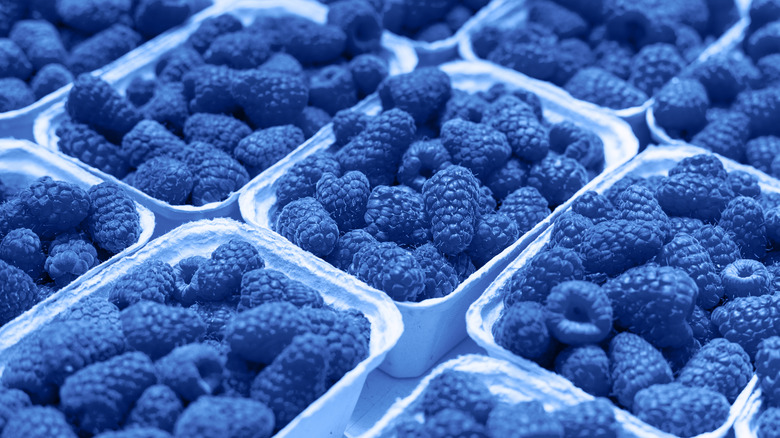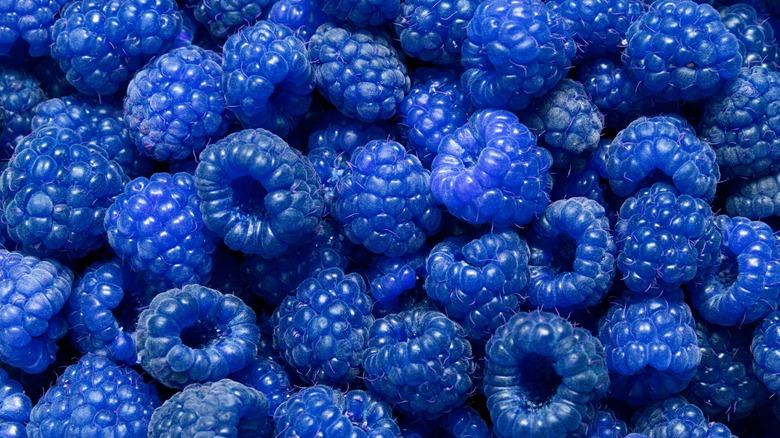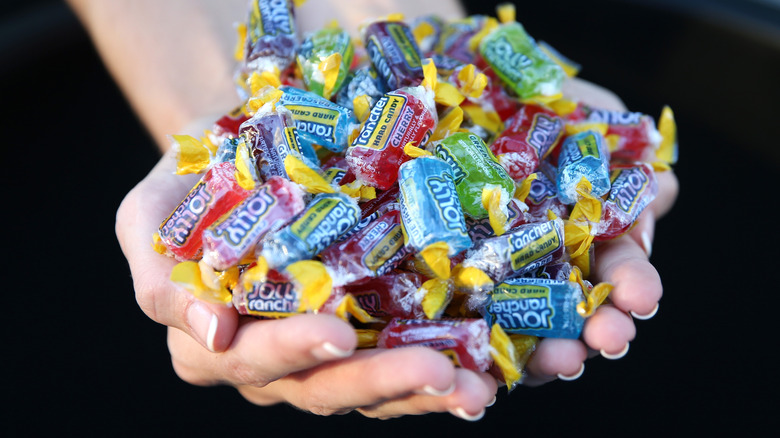Blue Raspberry May Have Been The Solution To A Toxic Red Dye Problem
The blue raspberry syrup that flavors products ranging from ICEE and Slurpee drinks to Kool-Aid and Jolly Ranchers isn't derived from blue raspberries — because those don't exist. It's actually a synthetic flavoring that combines sugary sweetness with fruit esters like banana and pineapple. However, the color is inspired by a type of raspberry: the white bark or blackcap raspberry, which turns a purple so deep it almost looks blue upon ripening.
Color, more than flavor, has driven the widespread popularity of blue raspberry. Blue, like red, is a vibrant color that appeals to young consumers. But unlike red — specifically Red No. 2, a dye that was ubiquitous in the 1970s for food products labeled as cherry, raspberry, or strawberry flavored — blue is not toxic. Red No. 2, also known as amaranth, was banned in 1976 after studies linked the dye to cancer in lab rats.
This revelation made blue an attractive alternative as a color additive for artificially flavored foods. Blue No. 1 quickly replaced Red No. 2 in usage. Interestingly, the flavor of blue raspberry products, colored with Blue No. 1, isn't much different from those labeled as red raspberry. However, color does influence how we perceive taste.
The evolution of color additives in American food products
As of July 2023, only seven certified color additives are approved for use in food by the U.S. Food and Drug Administration (FDA), although some natural sources of dye and pigment are exempt from certification. There used to be many more certified additives. For instance, Orange No. 1 was banned in 1956 after an outbreak of post-Halloween illnesses was attributed to candy containing that food coloring.
Before getting banned in 1976, Red No. 2 actually underwent rigorous testing in the 1950s. The results were deemed inconclusive, but there were already indications that this vivid color additive could cause cancerous tumors. Despite these concerns, its use persisted and was so widespread in the 1970s that foods incorporating it accounted for an estimated $10 billion in annual revenue. When it was banned in 1976, a large contingent of candy, soft drink, and other food manufacturers began clamoring for an alternative.
Fortunately for them, a new flavor called blue raspberry had recently entered the market. When paired with Blue No. 1 — also known as brilliant blue, a color additive that had received FDA approval in 1969 — it proved to be exceedingly popular.
The rise of blue raspberry
Do we need artificial colors and flavors in our food? The answer, of course, is no. These additives are included primarily for marketing and sales purposes. Color affects taste, and vibrant hues can make food seem more appealing. They also help differentiate packaging, allowing products to stand out on supermarket shelves.
The emergence of blue raspberry just before the ban of Red No. 2 is likely not entirely coincidental. Controversy had surrounded Red No. 2 products for years before the colorant was finally banned, allowing time for blue raspberry to be introduced as a viable alternative. The color and flavor combination was used by ICEE for slushy drinks in the early 1970s, and found immediate success.
Naturally, other products soon debuted their own blue raspberry flavors. Airheads introduced blue raspberry taffy in 1985, and Jolly Rancher added the flavor to its candy lineup in 2011. More than 50 years after its initial use, blue raspberry has become so ubiquitous that it's easy to forget why this color and flavor combination rose to prominence in the first place — because the alternative was toxic.



